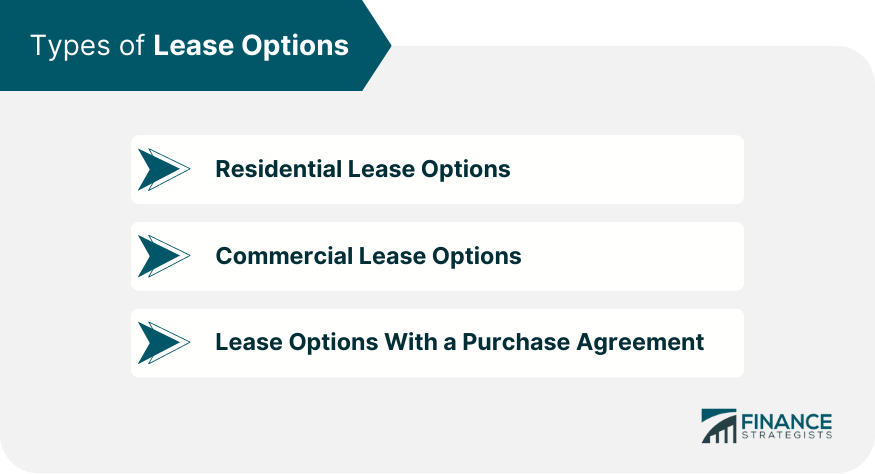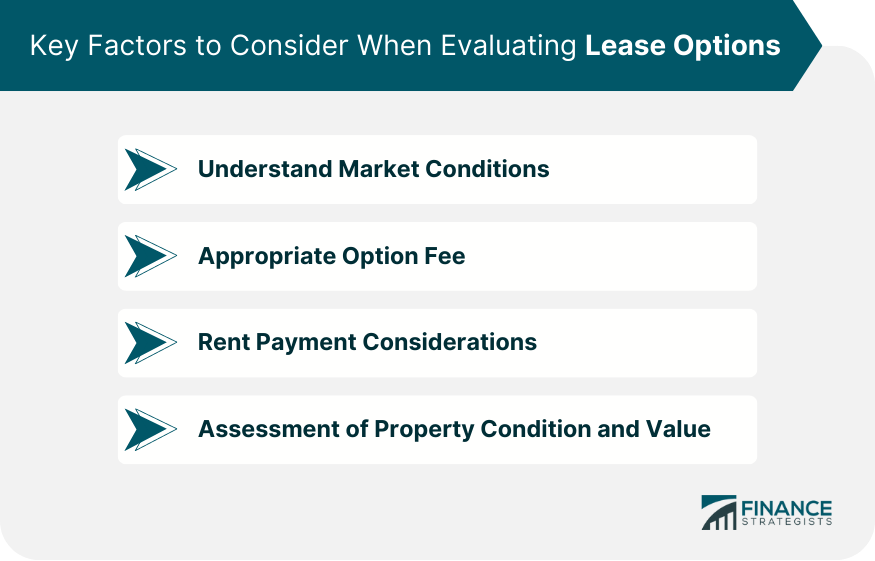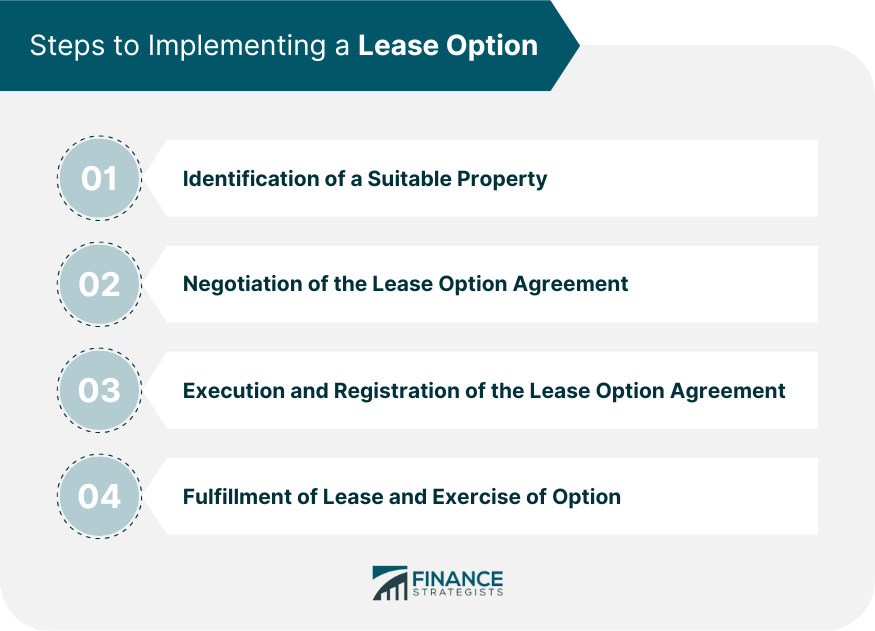Lease options, also known as "lease with the option to purchase," are agreements where a tenant is given the right to buy a property at a predetermined price within a specific period. Essentially, it's a rental contract with the added benefit of a purchase option. The purpose is to facilitate property acquisition for tenants who might not be ready to buy outright, allowing them to secure a purchase price and build equity through rent. Understanding lease options could open new pathways for homeownership or investment, particularly if upfront financing is a challenge. It offers a flexible approach to property ownership in diverse economic climates. Lease options play a vital role, offering alternative, creative financing methods that could suit a variety of individual circumstances and goals. Residential lease options are agreements on residential properties. They are popular among people who may not qualify for a traditional mortgage due to a low credit score or insufficient savings for a down payment. Commercial lease options, though less common than residential ones, involve commercial properties. Businesses may use these options to secure a location for the future expansion of their operations. A lease option can be paired with a purchase agreement, where the tenant agrees to buy the property at the end of the lease term. This can provide additional security for both parties, as it sets the expectations and terms of the potential sale from the beginning. A lease agreement outlines the rental details. It covers the rental amount, terms of payment, and the lease's duration, usually a few years. The option agreement stipulates the option fee (typically 2-5% of the purchase price), the agreed-upon purchase price for the property, and the duration of the option period, which is often concurrent with the lease agreement. This segment clarifies who is responsible for the property’s maintenance and repairs during the lease period, often falling on the tenant in lease option agreements. The agreement must address who will handle property taxes and insurance. In many cases, the landlord continues to pay these costs, factoring them into the rent. Before entering a lease option, both parties should have a good grasp of the current and projected real estate market conditions. The agreed-upon purchase price will remain fixed, so if the market value of the property changes significantly, one party could benefit at the expense of the other. The option fee is negotiable, and its amount can significantly impact the agreement's attractiveness. Lessees should consider how the option fee fits into their financial plan, while lessors should weigh the potential income against the potential risk. The agreement should clarify whether a portion of the rent will contribute towards the purchase price if the lessee decides to buy. This arrangement can make a lease option more appealing to potential buyers. A comprehensive assessment of the property, including a home inspection and appraisal, is crucial before signing a lease option agreement. This helps ensure the purchase price aligns with the property's current market value and condition. The enforceability and specifics of lease options can vary by state. It's crucial for both parties to understand their state's laws regarding lease options before entering into an agreement. Lease options fall under various federal and state consumer protection laws. These regulations protect lessees from unfair or deceptive practices, ensuring they fully understand the agreement terms. Lease options must be written contracts to be legally enforceable. If disputes arise, courts will look to the agreement to resolve them. As such, both parties should consult with a real estate attorney before signing. The lessor typically reports rent as income and continues to take deductions for mortgage interest and property taxes. The lessee can't take property tax or interest deductions as they don't own the property. However, if the lessee buys the property, they could potentially deduct the portion of rent that was applied to the purchase price. Timely payments can positively impact the lessee's credit score, while missed payments can have a negative impact. The lessor's credit score generally isn't affected unless the lease option leads to financial hardship or mortgage default. Risks for lessors include potential damage to the property, non-payment of rent, or a decrease in property value. Lessees risk losing the option fee and any rent credits if they choose not to buy or are unable to secure a mortgage at the end of the lease. The first step in a lease option agreement is finding a suitable property that meets the lessee's needs and budget. Once a property is identified, the lessee and lessor negotiate the terms of the lease option agreement, which include the rental price, option fee, purchase price, and terms of maintenance and repairs. After agreeing on terms, the parties sign the lease option agreement. This agreement should be registered with the appropriate governmental office to ensure its legality and enforceability. The lessee moves into the property and begins paying rent. If the lessee decides to purchase the property, they notify the lessor and move forward with the home-buying process. Lease options offer a unique avenue toward homeownership or investment, combining the simplicity of leasing with the potential of ownership. These innovative arrangements could particularly benefit those struggling with the stringent requirements of traditional financing. From residential to commercial contexts, lease options are designed to cater to diverse needs and circumstances. Critical to their success is a proper evaluation of market conditions, financial planning around the option fee and rent, and a thorough assessment of the property. Legal considerations and financial implications, such as tax consequences and impact on credit scores, underline the importance of professional advice when negotiating lease options. As economic climates shift and real estate markets evolve, lease options will likely continue to play a significant role. Understanding and effectively leveraging them could open doors to new opportunities in the world of property acquisition.What Are Lease Options?
Types of Lease Options
Residential Lease Options
Commercial Lease Options
Lease Options With a Purchase Agreement

Anatomy of a Lease Option Agreement
Lease Agreement
Option Agreement
Maintenance and Repairs
Property Taxes and Insurance
Key Factors to Consider When Evaluating Lease Options
Understanding Market Conditions
Appropriate Option Fee
Rent Payment Considerations
Assessment of Property Condition and Value

Legal Considerations for Lease Options
Lease Option Laws by State
Consumer Protection Laws
Contract Enforceability
Financial Implications of Lease Options
Tax Implications for Both Parties
Effect on Credit Scores
Risks and Potential Financial Drawbacks
Steps to Implementing a Lease Option
Identification of a Suitable Property
Negotiation of the Lease Option Agreement
Execution and Registration of the Lease Option Agreement
Fulfillment of Lease and Exercise of Option

Final Thoughts
Lease Options FAQs
A lease option is a contract in real estate where a landlord rents a property to a tenant with the added option of purchasing the property at a predetermined price within a fixed timeframe. It combines aspects of a traditional lease and a real estate purchase into a single contract.
A lease option allows a tenant to move towards homeownership while still renting. It provides an opportunity to lock in a purchase price, build credit, and save for a down payment. It's particularly beneficial for those who might not currently qualify for a traditional mortgage.
With a lease option, the tenant risks losing the option fee and any premium rent payments if they decide not to buy or cannot secure financing. For the landlord, there is the risk of property damage, non-payment of rent, or a decline in property value.
When evaluating a lease option agreement, consider the current and predicted future real estate market conditions, the agreed-upon purchase price, the option fee, the terms of maintenance and repairs, and the legal enforceability of the agreement in your state.
Yes, lease options are legally enforceable if properly constructed and compliant with state and federal laws. Both parties should consult with a real estate attorney before entering into a lease option agreement to ensure its legality and enforceability.
True Tamplin is a published author, public speaker, CEO of UpDigital, and founder of Finance Strategists.
True is a Certified Educator in Personal Finance (CEPF®), author of The Handy Financial Ratios Guide, a member of the Society for Advancing Business Editing and Writing, contributes to his financial education site, Finance Strategists, and has spoken to various financial communities such as the CFA Institute, as well as university students like his Alma mater, Biola University, where he received a bachelor of science in business and data analytics.
To learn more about True, visit his personal website or view his author profiles on Amazon, Nasdaq and Forbes.















